Tributary Whitewater Tours
Standard Operating Procedures (SOPs)
All trips must include a trip pack, a pre-trip guide meeting, a safety talk, a paddle talk per boat, a trip unpack, and a guide de-brief.
The meet time and location for each trip is available via Arctic. If you are unsure on how to find that information within Arctic please follow these guides:
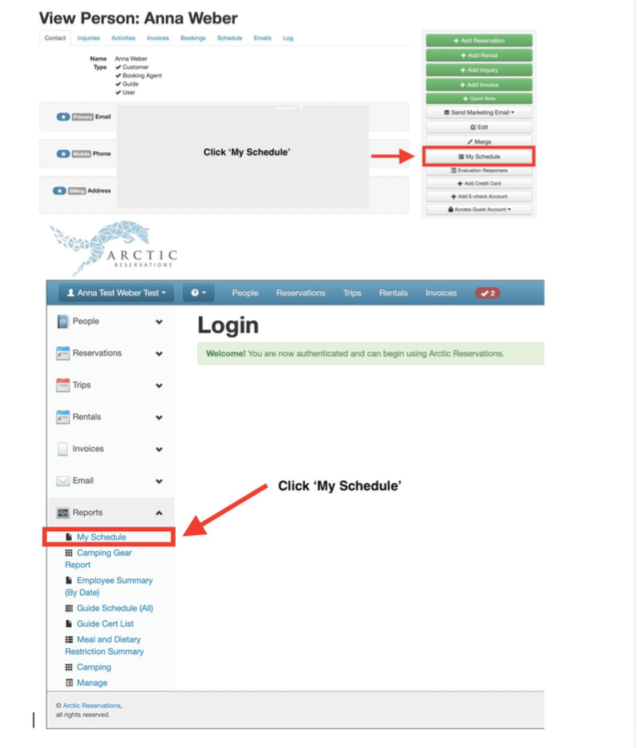
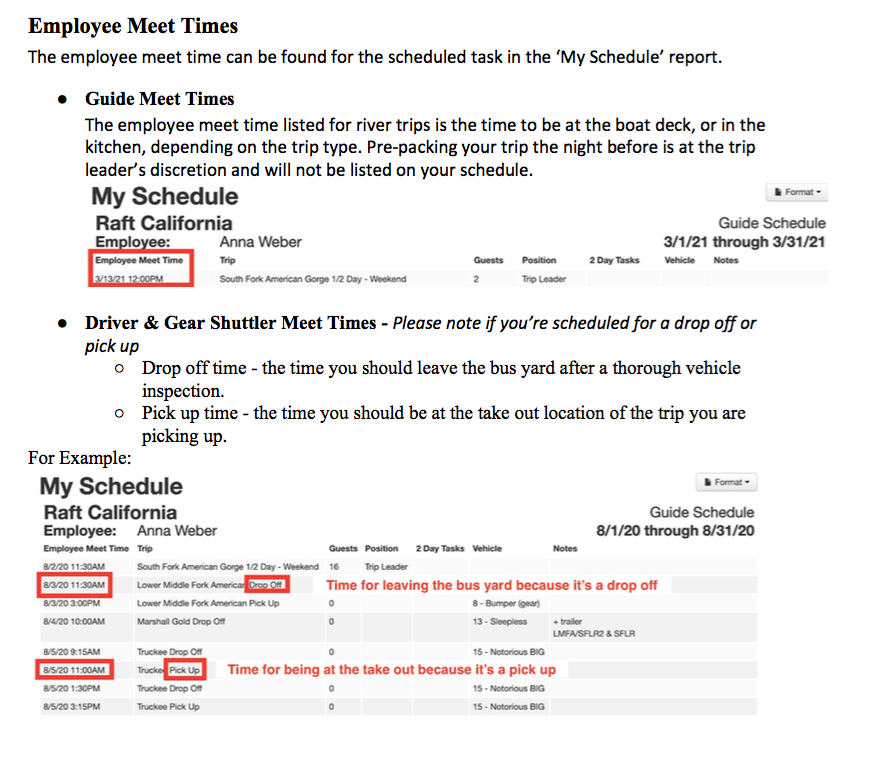
Arctic will designate where to meet
Camp Kitchen
Small Deck
Big Deck
Truckee Outpost
Deschutes
It is the morning of your trip and you head to the boat deck with all of your PG to start your trip. It is critical to be on time, or even a bit early, to ensure you are involved in all aspects packing for your rafting trip. You are expected to be present and ready to work by your designated meet time. Prior to showing up to pack your trip you should know how many guests are scheduled for your trip and how many guides will be on your trip, in order to know the quantities of equipment that is needed. Most of the time the trip leader (TL) or equipment manager (EQ) will have the amount of paddles, boats (how many and which ones), throwbags, PFDs (amount of adult vs. youth), helmets, and other equipment listed on the white board to guide the trip pack. The TL or EQ will also know which vehicles and trailers are needed. It is important to work slowly and cautiously while communicating with fellow guides because lifting rafts and other equipment on and off of vans and trailers can be dangerous, when done incorrectly. It is also critical to be thorough because it is incredibly embarrassing and unprofessional to forget necessary equipment. A smooth and thorough trip pack is a fantastic way to start a trip!
Items to be completed during the packing of a trip:
A critical step before getting on the water for any trip, is the pre-trip all guide meeting. This is typically done after all guests have arrived and are checked in, and is led by the TL. This is the time for the guide staff on that trip to get on the same page. Not only does this ensure we run the safest trip possible but it also allows for a smoother trip.
Items to be discussed during the pre-trip meeting:
The safety orientation presented to each set of guests prior to their river trip includes the most important safety topics pertaining to their trip. This safety briefing is typically presented by the trip leader. It is critical to present all of the information in a manner that is understood by the guests. It typically lasts 5-10 minutes and is common to lose guest’s attention mid-way through the presentation, so finding ways to make it interactive and engaging is critical. It is also common for guests to be slightly frightened following the safety talk. Adding bits to keep the safety talk light and informational lead to a smoother trip, and ultimately a better guest experience.
Items to be discussed during the safety talk:
The paddle talk is to be presented to each boat of guests by their river guide. A well developed paddle talk should convey all of the information the guests will need to help you, as the guide, effectively maneuver the raft downstream. This is typically done while the boat is still on shore, yet some components of this talk can be discussed while the boat is in the water and all the guests have loaded into the raft.
Guests’ paddle performance is directly related to the quality of the paddle talk presented to them by their guide. The more thorough, relatable, and understandable you are the better your crew will perform. This will ultimately lead to a smoother trip with a higher level of an experience for guests. Please take this time to reach out to your guests in a way that will help them get to know you as a guide. You should be able to complete your paddle talk in around five minutes.
Items to be discussed during the paddle talk:
Please allow guides on your trip enough time (around 15 minutes) to say goodbye to guests prior to unpacking the trip, or please be considerate of fellow guides if you want to hang out with your guests following the trip.
While it might feel like your job is done once you have said goodbye to your guests, unpacking trip gear is an overlooked part of the day. It is important to do all steps correctly, thoroughly, and cautiously to ensure all of the gear is stored in a way that you would like to find it the next time you walk up to the boat deck to pack a trip. It is also important to work slowly and cautiously while communicating with fellow guides because lifting rafts and other equipment off of vans and trailers can be dangerous, when done incorrectly. Please take the time it takes to do these steps correctly. If you fail to finish all tasks of the trip unpack your trip will be considered incomplete.
Items to be completed during the unpack of a trip:
After the trip is unpacked, the last step is for all of the guides on the trip to group up in order to debrief and discuss the day. Similar to the pre-trip meeting this debrief will be led by the TL to discuss what went well during the trip, and what could have been executed better. Tributary Whitewater Tours is continuously striving to better our company and our guides, and there is no better way to achieve that goal than by politely discussing how we can improve as a whole. This is not the time to degrade co-workers, rather a time for constructive feedback.
Items to be discussed and completed during the pre-trip meeting:
All trip leaders must complete the following tasks to ensure that you will be compensated for the additional pay for each trip. It is your responsibility as the trip leader that all tasks are either done by you or delegated accordingly to the other guides to ensure a perfect trip. The following tasks and responsibilities necessary for each trip include:
If an incident occurred on the trip, and the first aid kit was used, the first aid kit needs to be resupplied and sealed with a new zip tie.
TLs are responsible for the documentation of the trip. This includes: the post-trip report, ensuring all waivers are filled out, and the trip ticket (if applicable) is filled out and dropped off.
Trip tickets need to be filled out completely and properly, including put-in and take-out times. The top copy (blue) needs to be turned in on the day of the trip to the ranger box at put-it, or handed to a ranger directly. The bottom two copies (yellow and pink) can be left in the guide paperwork folder in the van you used.
It is critical that the numbers submitted on the trip ticket match the numbers the TL enters into their Post-trip report. Any guides training on that section of river must be counted as trainees, any friends that add to the trip can be counted as guests.
Upper Middle Fork:
Lower Middle Fork:
Nork Fork American:
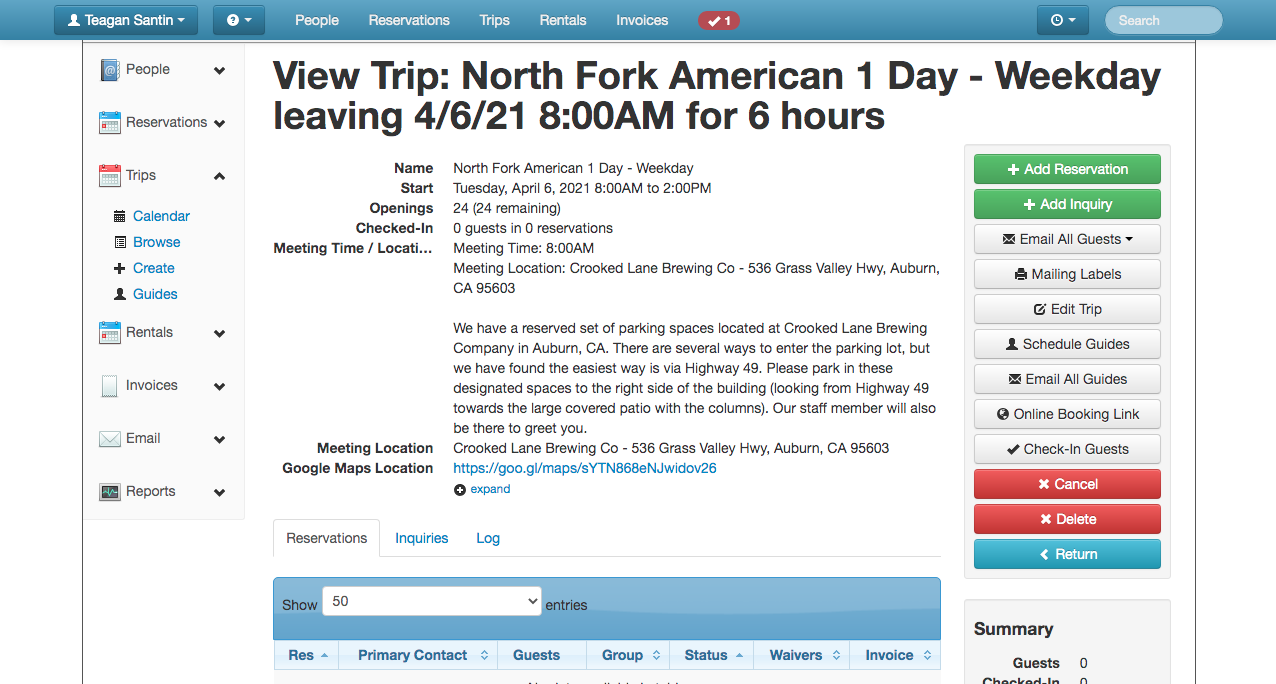
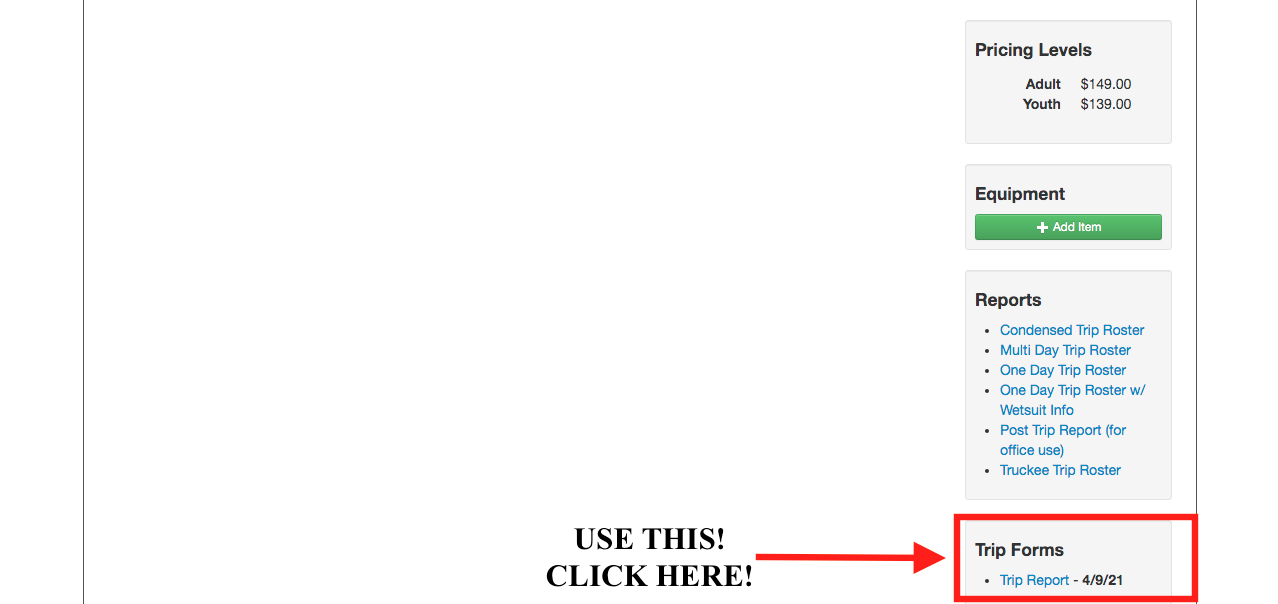
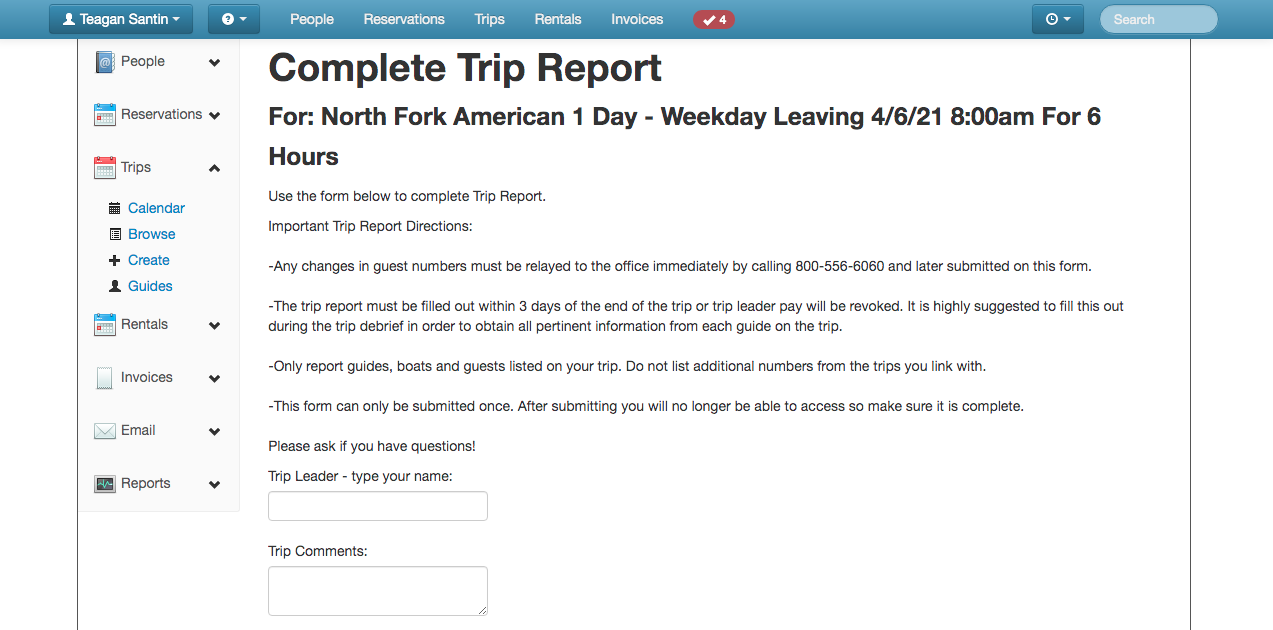


Please take the time to familiarize yourself with the new trip report.
Any time the first aid kit is opened, an incident report must be filled out. Incident reports are found in the document file boxes/folders in Big Deck Shed, Small Deck Shed, and vehicles. These need to be filled out with the customer, and given to the Manager on Duty (MOD) that day.
The goal is for all waivers to be submitted by guests before they arrive for their trip. However, there will be times where paper waivers are still needed. If you have guests fill out paper waivers on a trip, please leave them in the guide zipper pouch in the van you used.
Work in Progress (WIP)- Oregon information coming soon
Class | II-III | IV | V |
Ride-Along | 2x | 2x | 1x or guide boat |
Turkey Boat | 3x | 1x | 1x or ride along |
Specifics | PFD Helmet Knife Whistle 3-2-1 J-stroke Trucker’s Hitch | All previous items + Dry bag Mesh bag Lunch rig Throw bag River specific knowledge | All previous items + River specific knowledge
|
*All designated check-off guides will be trained on how to use this system to oversee check-off trips.
**The number of trips required to check-off on river sections is determined by guide class level. (Example: if a class V guide is checking off on a new class III section, they will follow the class V check-off criteria, which is 1 guide boat or 1 ride-along).
A ride-along is riding in a raft with a paid guide during a commercial trip. A turkey boat is a boat full of trainees working together to train on a section of river. You must track these trips in your river log and have the TL of the trip, or a check-off guide sign off that they witnessed the completion of that trip.
If you wish to be scheduled for ride-alongs or wish to tag along with a commercial trip as a turkey boat please reach out to schedule@raftcalifornia.com. Once you have all items completed within the graph and feel ready for a check-off trip please reach out to training@raftcalifornia.com.
Printable PDF coming soon!
River/River Section | Flow (cfs) | Date | Trainer Initials |
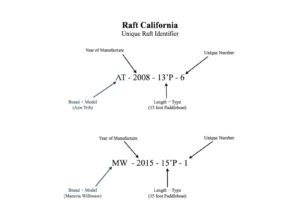
If damage to a raft occurs or you notice damage to a raft on your trip please use this unique identification system to label the raft within the post-trip report. This will help standardize the way we label boats for further clarification. If the boat needs immediate repair please roll in a way the raft identifier is visible.
Multiple river trips we offer require us to carry one of our Somewear devices or radios. The Somewear device will be carried by the TL as well as a charged cell phone. It is the responsibility of the TL to make sure the device is charged and synced to their phone to use in case of emergency. If radios are required, the TL will carry one and leave the other one with a driver. At the end of the day all comms devices must be placed in their designated location in the Big Deck Shed.
The device will be carried on the following rivers:
Prior to using the Somewear device you will need to have the Somewear app downloaded to your smart phone. Turn on Bluetooth on your smartphone. Open Somewear app. Press and hold the power button on the Somewear device for 5 seconds until the white light starts blinking. Press the “Connect Hotspot” button on the app. Once the device is paired you can open a new message by pressing the “+” on the top right of the app screen. Select a person from your contact list and send a message.
If you need immediate EMS assistance you can trigger the SOS option.
Two way radios will be used to contact drivers, if necessary, on the following rivers:
When cooking a burger lunch, please only cook 1 burger per guest and guide, to start. After burgers have been served, take an order for who might want a second burger.
Our camp kitchen is the common hub for 2-day trips as it is where we provide meals to our guests throughout their trip. It is critical to keep this area clean, sanitized, and organized. The following SOPs will help to guide you through providing the best food experience for our guests.
After every trip out of Camp (SFL,SFU, SFFR, SFW, SF2, Deschutes ½ Day, Deschutes Full Day) bathrooms must be checked to make sure they are clean and presentable.
This includes:
Wilderness trips are some of the most coveted trips run by Tributary Whitewater Tours, however there are some extra steps to clean and put away the extra gear that is required for these trips.
Wilderness trip packing list
On wilderness trips we offer sleep kits for guests, these will be premade by the guides while packing the trip. Each kit provides enough sleeping gear for 4 guests. Per 4 guests you will pack 1 sleep kit, and 1 Bills bag per person.
This sleep kit includes (4 guests):
All wilderness trips will pick their food up from the commissary, except for Middle Fork Wilderness and South Fork Wilderness trips.
Tupperwares from the commissary can be snapped closed and placed directly back into the cooler. No need to wash them.
While it might not be the most glamorous task of the wilderness trip clean-up, groovers must be cleaned after every trip they are used. When done correctly, this is a painless and mess-free task.
Steps to be taken for a clean groover:
The commissary box must be thoroughly cleaned out using the sink on the Big Deck following every use. Please be diligent with this process, as it is frustrating to open a dirty comm. box.
Items to be completed for a clean comm. box:
We launch trips on many different rivers in California, Oregon and Idaho. For questions give our main office a call – we would love to talk with you about our trips and rivers.
Our vision is to create a sustainable and equitable reality where our rivers are enjoyed and protected, a place where families and friends can be inspired and challenged.
Tributary Whitewater Tours has been running rivers since we were first founded in 1978. Since we opened 40+ years ago we have expanded to include Adventure Connection, Mariah Wilderness Expeditions, High Desert River Outfitters, Canyon Outfitters and are the parent company of Raft California and Raft Oregon. While some things have changed over the years, Tributary remains a family-run small business with the same passion for the river and the mission of leading others to experience it.
© 2022, Tributary Whitewater LLC, All Rights Reserved